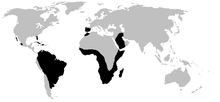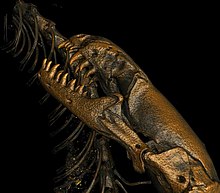Amphisbaenia
| Amphisbaenians | |
|---|---|

| |
Blanus cinereus , Spain
| |
| Scientific classification | |
| Domain: | Eukaryota |
| Kingdom: | Animalia |
| Phylum: | Chordata |
| Class: | Reptilia |
| Order: | Squamata |
| Superfamily: | Lacertoidea |
| Clade: | Amphisbaenia Gray, 1844 |
| Families | |

| |
| Black: range of Amphisbaenia | |
Amphisbaenia
Description

Despite a superficial resemblance to some primitive snakes, amphisbaenians have many unique features that distinguish them from other reptiles. Internally, their right lung is reduced in size to fit their narrow bodies, whereas in snakes, it is always the left lung. Their skeletal structure and skin are also different from those of other squamates.[2] Both genetic and recent fossil evidence indicate that amphisbaenians lost their legs independently from snakes.[3]
The head is stout, not set off from the neck, and either rounded, sloped, or sloped with a ridge down the middle. Most of the skull is solid bone, with a distinctive single median tooth in the upper jaw. It has no outer ears, and the eyes are deeply recessed and covered with skin and scales. These rudimentary eyes have a

Amphisbaenians have a distinctive skin made up of rings of scales (annuli) that form a tube in which the loosely attached trunk of the body moves. Burrowing is achieved with an accordion-like motion, with longitudinal muscles in the skin bunching up the annuli, anchoring it to the surrounding soil, and trunk muscles moving the body forward or backwards within the integumentary tube.[7]
Amphisbaenians are carnivorous, able to tear chunks out of larger prey with their powerful, interlocking teeth. Like lizards, some species are able to shed their tails (
The red worm lizard (Amphisbaena alba) is often found in association with leafcutter ants. This reptile is thought to forage in the ants' deep galleries, where the insects deposit their waste. The presence of these reptiles is easily explained by the fact that they prey on the larvae of large beetles that also inhabit the leafcutter ants' galleries.[8]
Amphisbaenians have often been categorized by their skull shape. The specialized skull shape is hypothesized to be driven by environmental and ecological conditions, such as soil type, and is an instance of convergent evolution.[9] Traditionally four types of skulls are recognized; “shovel-headed,” “round-headed,” “keel-headed,” and “spade-headed”, although it doesn't say anything about the relationship between the types.[10] Of these four morphotypes, the round-headed species produce the lowest burrowing forces, the shovel-headed species the second lowest forces, the keel-headed species the second highest forces, and the spade-headed the highest forces.[11]
Distribution
Amphisbaenians are found in North America, Europe, Africa, South America, the Middle East, and the Caribbean, a surprisingly large distribution despite being small subterranean animals that rarely ever leave their burrows. Initially, this large distribution was thought to be due to
Evolution

The fully limbed Slavoia darevskii from the Late Cretaceous (Campanian) of Mongolia may represent an early relative of amphisbaenians.[14] The oldest known modern amphisbaenians are members of Rhineuridae and the extinct family Oligodontosauridae from the Paleocene of North America. Modern amphisbaenians likely originated in North America, before dispersing to South America, Africa and Europe via rafting during the Paleogene.[15]
Taxonomy
The most ancient branch of the tree is the Rhineuridae. The remaining five families form a group to the exclusion of rhineurids. Bipedidae, Blanidae, and Cadeidae represent the most ancient divergences within this grouping, with Trogonophidae and Amphisbaenidae diverging more recently.[19] South American amphisbaenids apparently are derived from African amphisbaenids that rafted across the Atlantic in the Eocene, about 40 million years ago.[19] Cuban cadeids may be similarly derived from blanids that rafted across from northwestern Africa or southwestern Europe in a similar time frame.[19]
Historically considered to be lizards, some studies have suggested that they should be considered separate from lizards,[20] though many modern studies consider them to be true lizards, as they are closely related to other lizards of the clade Lacertoidea.[1]
Families
Six families of amphisbaenians are currently recognised:[21]
- Amphisbaenidae Gray, 1865 – Amphisbaenids, tropical worm lizards of South America, some Caribbean islands, and Sub-Saharan Africa.[22] (12 genera, 182 species)[23]
- Bipedidae Taylor, 1951 – Only in Mexico and commonly called ajolotes,[24] but not to be confused with axolotls (1 genus, 3 species)[25]
- Trogonophidae Gray, 1865 – Palearctic worm lizards[31] (4 genera, 6 species)[32]
Phylogeny
The following cladogram shows the relationships between the six amphisbaenian families determined in the phylogenetic analysis of mitochondrial and nuclear genes by Vidal et al. (2008).[19]
| Amphisbaenia |
| |||||||||||||||||||||||||||||||||
References
- ^ ISSN 0300-3256.
- ^ ISBN 0-12-178560-2.
- PMID 21593869.
- ^ Foureaux, G., Egami, M.I., Jared, C., Antoniazzi, M.M., Gutierre, R.C., Smith, R.L., 2010. Rudimentary eyes of squamate fossorial reptiles (amphisbaenia and serpentes). John Wiley & Sons, Hoboken, NJ. 293(2): 351–7.
- PMID 33732432.
- PMID 33870497.
- ^ "Amphisbaenia". Vertebrate Diversity. Grant Museum of Zoology, UCL. Retrieved 9 May 2020.
- Greenwood Press.
- .
- PMID 37849246.
- ^ A comparison of postcranial osteology and associated burrowing performance of four amphisbaenian morphotypes
- PMID 15324836.
- ^ a b Longrich, N., Vinter, J., Pisani, D., Pyron, A., Gauthier, J. 2015 Biogeography of worm lizards (Amphisbaenia) driven by end-Cretaceous mass extinction. Proceedings of the Royal Society B, 282 http://rspb.royalsocietypublishing.org/content/282/1806/20143034
- .
- PMID 25833855.
- ^ Kearney, Maureen, and Bryan L. Stuart. "Repeated evolution of limblessness and digging heads in worm lizards revealed by DNA from old bones." Proceedings of the Royal Society of London B 271 (2004): 1677–1684.
- ^ Mott, T., Vieites, D.R., 2009. Molecular phylogenetics reveals extreme morphological homoplasy in Brazilian worm lizards challenging current taxonomy. Molecular Phylogenetics & Evolution. 51(2): 190–200.
- ^ Vanzolini, P.E., 2002. An aid to the identification of the South American species of Amphisbaena (Squamata, Amphisbaenidae). Pap. Avulsos Zool, São Paulo, 42(15): 351–362.
- ^ PMID 18077239.
- ^ Bates, M. F. (1993). Amphisbaenians—What are they? Culna, 45, 7–10.
- The Reptile Database. Retrieved 10 November 2020.
- ^ "Amphisbaenidae". Integrated Taxonomic Information System. Retrieved 19 August 2007.
- The Reptile Database. Retrieved 10 November 2020.
- ^ "Bipedidae". Integrated Taxonomic Information System. Retrieved 19 August 2007.
- The Reptile Database. Retrieved 10 November 2020.
- ^ "Blanidae". Dahms Tierleben. www.dahmstierleben.de.
- The Reptile Database. Retrieved 10 November 2020.
- The Reptile Database. Retrieved 10 November 2020.
- ^ "Rhineuridae". Integrated Taxonomic Information System. Retrieved 19 August 2007.
- The Reptile Database. Retrieved 10 November 2020.
- ^ "Trogonophidae". Integrated Taxonomic Information System. Retrieved 19 August 2007.
- The Reptile Database. Retrieved 10 November 2020.
Further reading
- ISBN 0-88359-042-5. (Suborder Amphisbaenia, pp. 201–202).
- Gans C (2005). "Checklist and Bibliography of the Amphisbaenia of the World". Bulletin of the American Museum of Natural History (289): 1–130.
- ISBN 0-7167-0020-4. (Suborder Amphisbaenia, pp. 276–278).
- Gray JE (1844). Catalogue of the Tortoises, Crocodiles, and Amphisbænians, in the Collection of the British Museum. London: Trustees of the British Museum. (Edward Newman, printer). viii + 80 pp. ("Amphisbænia", new order, p. 68).
